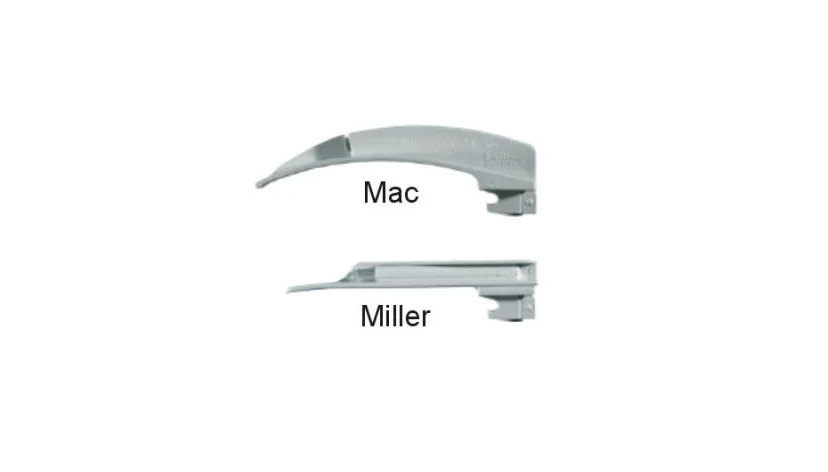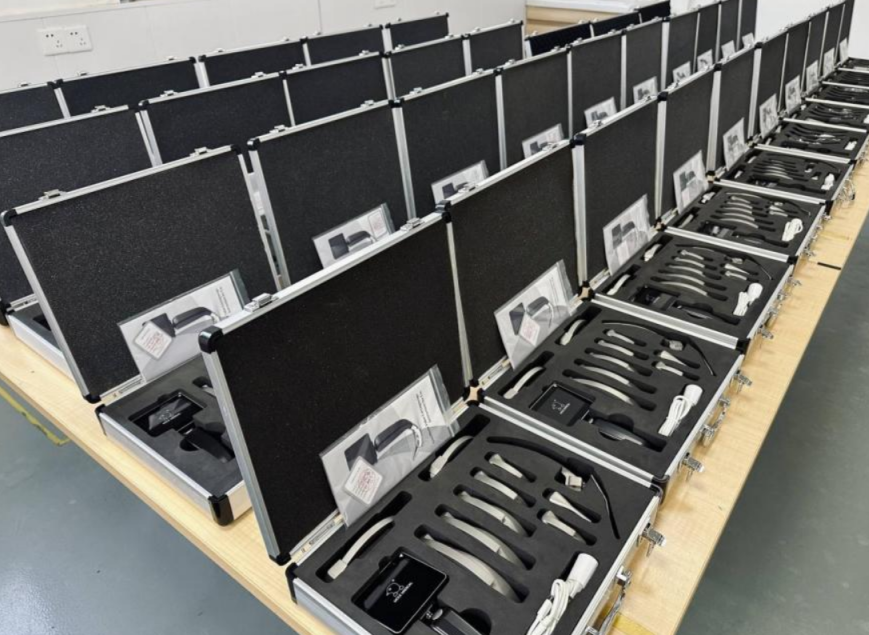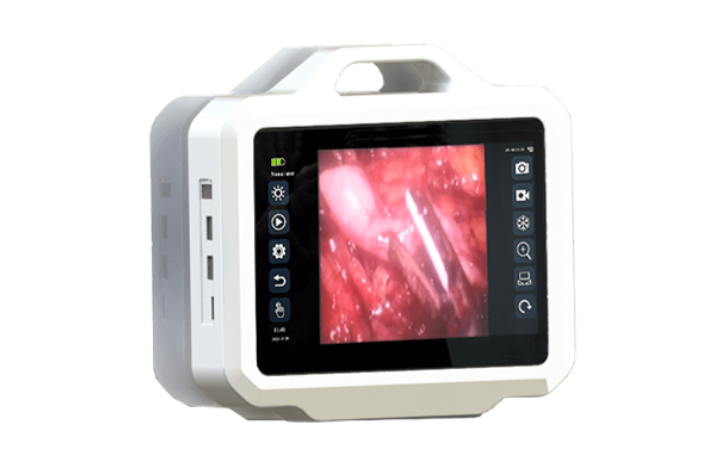Miller Blade vs. Mac Blade: Understanding the Differences in Anesthesia Practice
Apr 18, 2024
Laryngoscope blades play a pivotal role in ensuring successful intubation during anesthesia procedures. Among the array of laryngoscope blades available, the Miller and Mac blades stand out as two common types used by anesthesiologists worldwide. Developed by Mole Medical, these blades differ in their design and intended use, making it crucial for medical professionals to understand their nuances for optimal patient care.
Anatomy and Design
1. Miller Blade Anatomy and Design
The Miller blade features a straight, elongated design with a curved tip. Its narrow profile allows for better visualization of the vocal cords, making it particularly useful in patients with limited mouth opening or a high larynx. The blade is available in various sizes, catering to different patient populations.
2. Mac Blade Anatomy and Design
In contrast, the Mac blade has a curved design with a wider blade and a more pronounced curve at the tip. This curvature facilitates lifting the epiglottis to expose the glottis, making it ideal for patients with normal airway anatomy. Like the Miller blade, the Mac blade is also available in different sizes to accommodate varying patient needs.
3. Key Structural Differences
While both blades serve the same purpose, their structural differences are evident. The Miller blade’s straight design allows for better maneuverability in patients with limited mouth opening, while the Mac blade’s curvature facilitates epiglottis elevation in patients with a normal airway.
Indications and Intended Use
1. Indications for Using a Miller Blade
The Miller blade is typically indicated in patients with restricted mouth opening, such as those with micrognathia or temporomandibular joint disorders. Its narrow profile allows for easier insertion into the oral cavity and better visualization of the vocal cords, enhancing intubation success rates in these cases.
2. Indications for Using a Mac Blade
Conversely, the Mac blade is preferred in patients with normal airway anatomy or those with a relatively large mouth opening. Its curved design facilitates lifting the epiglottis to expose the glottis, providing an optimal view for intubation. Additionally, the Mac blade may be favored in patients with limited neck mobility due to its ergonomic design.
3. Choosing the Right Blade
While both blades have their specific indications, there may be scenarios where one type of blade is preferred over the other based on patient anatomy or clinical situation. For instance, in pediatric patients with micrognathia, the Miller blade may be the preferred choice due to its narrower profile and ease of insertion. However, in adult patients with a normal airway, the Mac blade may provide better exposure of the glottis, leading to smoother intubation.
Visualization and Exposure
1. Comparison of Miller Blade:
Miller blades offer excellent visualization of the vocal cords due to their straight, narrow design. This design allows for direct lifting of the epiglottis, providing a clear view of the glottis. However, in cases where there is limited space or the patient has a high larynx, visualization may be challenging.
2. Comparison of Mac Blade:
On the other hand, Mac blades provide broader exposure to the laryngeal structures by lifting the epiglottis indirectly. The curved design of the Mac blade facilitates this lifting action, resulting in a wider field of view. This can be particularly advantageous in patients with normal airway anatomy or those with limited neck mobility.
3. Impact on Intubation Success:
The choice between Miller and Mac blades can significantly impact intubation success rates based on visualization capabilities. In cases where direct visualization of the vocal cords is crucial, such as patients with restricted mouth opening, the Miller blade may be preferred. Conversely, in patients with a normal airway or those with limited neck mobility, the Mac blade’s broader exposure may lead to smoother intubation.

Techniques and Tips
1. Using Miller Blades Effectively:
Ensure proper positioning of the patient’s head and neck to optimize visualization.
Use gentle but firm pressure to lift the epiglottis and expose the glottis.
If visualization is inadequate, consider using adjuncts such as a stylet or a bougie to guide the endotracheal tube into the trachea.
2. Using Mac Blades Effectively:
Utilize the curvature of the Mac blade to indirectly lift the epiglottis.
Maintain a consistent angle of insertion to avoid trauma to the oropharynx.
Adjust the position of the blade as needed to obtain the best view of the glottis.
3. Common Pitfalls and Challenges:
With Miller blades, a common pitfall is inadequate visualization due to limited mouth opening or anatomical variations. To overcome this challenge, consider using a smaller-sized blade or employing alternative airway management techniques.
With Mac blades, difficulties may arise in patients with a large tongue or excessive secretions, leading to obscured visualization. Utilize suction to clear the airway and consider using a tongue depressor to optimize exposure.
Clinical Considerations and Conclusion
1. Key Differences Between Miller and Mac Blades:
Miller blades feature a straight, narrow design for direct visualization of the vocal cords, while Mac blades have a curved design for indirect epiglottis elevation and broader exposure.
The choice between Miller and Mac blades depends on patient anatomy and clinical scenario, with Miller blades preferred in cases of restricted mouth opening and Mac blades favored in patients with a normal airway.
2. Clinical Considerations for Blade Selection:
Consider factors such as patient age, airway anatomy, and clinical urgency when choosing between Miller and Mac blades.
Tailor blade selection to individual patient needs to optimize intubation success rates and minimize complications.
Mole Medical: Innovations in Laryngoscope Technology
As the manufacturer of both the Miller and Mac blades, Mole Medical has been at the forefront of laryngoscope innovation. By understanding the diverse needs of healthcare providers and patients alike, Mole Medical has developed blades that prioritize both efficacy and ease of use.

Through continuous research and development, Mole Medical remains committed to enhancing laryngoscope technology to meet the evolving demands of modern healthcare. Whether it’s refining blade designs for improved visualization or incorporating advanced materials for durability, Mole Medical continues to push the boundaries of innovation in laryngoscopy.
Conclusion
In conclusion, understanding the differences between Miller and Mac blades is crucial for anesthesiologists and other healthcare professionals involved in airway management. While both blades serve the same purpose of facilitating intubation, their anatomical differences and indications for use make them suitable for different patient populations and clinical scenarios. By selecting the appropriate blade based on patient anatomy and clinical need, healthcare providers can enhance intubation success rates and ensure optimal patient outcomes.
Categories
Latest Articles

The 90th China International Medical Equipment Fair (CMEF)
The 90th China International Medical Equipment Fair (CMEF) – a global event for the medical industry! This exhibition brings together global elites, focusing on medical innovation and development, and will be held in Shenzhen International Convention and Exhibition Center. From cutting-edge technology to market trends, CMEF is an ideal place for you to learn about ... Read more

YS-II video laryngoscopes are exported to South Korea in batches, and international cooperation continues to heat up!
Recently, the company continued to ship video laryngoscopes YS-II to the general agent in South Korea. This move not only marks the further deepening of the cooperative relationship between the two parties, but also demonstrates the strong competitiveness and broad prospects of Mole Medical in the international market. YS-II video laryngoscope, as a high-precision medical ... Read more

Exploring the Endotracheal Intubation Camera: Revolutionizing Airway Management
In the realm of medical procedures, innovations continually push boundaries to enhance patient care and procedural efficacy. Among these advancements, the endotracheal intubation camera stands out as a pivotal tool in managing complex airway scenarios. Whether in emergency settings or planned surgeries, this device plays a crucial role in ensuring successful intubation and facilitating various ... Read more

Understanding Equipment Needs for Bronchoscope for Dubbel Lumen Tube
In the field of anesthesia and critical care, the bronchoscope plays a crucial role in the insertion and management of Dubbel Lumen Tubes. These tubes are essential for lung isolation during thoracic surgeries or for managing patients with lung pathology requiring selective ventilation. Understanding the equipment needs for bronchoscope-assisted Dubbel Lumen Tube insertion involves assessing ... Read more

Exploring Advanced Bronchoscopy Equipment by Mole Medical
Mole Medical, a leading manufacturer in Xuzhou, Jiangsu Province, offers state-of-the-art bronchoscopy equipment designed to enhance diagnostic and therapeutic procedures. This blog delves into the features, functionalities, and advantages of Mole Medical’s innovative products, focusing on their Flexible Video Bronchoscope and Disposable Video Bronchoscope. Flexible Video Bronchoscope: Portability and Precision Content 隐藏 1 Flexible Video ... Read more



